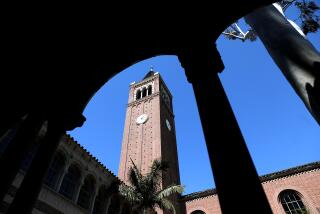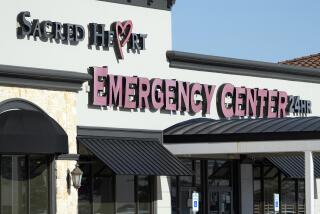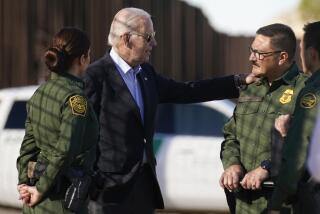Column: Another casualty of Trump’s Muslim ban: U.S. medical training and rural healthcare
- Share via
The chaos among immigrant families and at airports wreaked nationwide by President Trump’s executive order barring nationals of seven majority-Muslim countries from entering the United States has been well documented. Not as well understood are the effects his order will have on U.S. medical training and healthcare, especially in poor and rural neighborhoods.
Ahmad Masri and Mourad H. Senussi, two physicians at the University of Pittsburgh Medical Center, take an early look at the consequences in an article just published by the New England Journal of Medicine. Data on the national origin of doctors in the United States aren’t available, they note, but statistics derived from residency matching are. (Residency matching puts graduate doctors together with residency programs across the country to pursue training in their specialties.)
In 2013, Masri and Senussi report, there were 753 applicants for residencies whose country of citizenship at birth was Iran, Iraq, Libya, Sudan or Syria, five of the seven countries whose nationals are banned at least temporarily from entering the United States. The others are Yemen and Somalia.
Only the cream of the crop of medical students and physicians from foreign medical schools match into U.S. residency programs....’Extreme vetting’ at its best.
— Masri and Senussi, New England Journal of Medicine
Of those applicants, 299 were matched into a U.S. residency program. If the ban expands to include other countries with a Muslim-majority population, the number of affected doctors will rise: In 2013, there were 2,101 applicants from 11 different countries with a Muslim majority, of which 40% were matched into a U.S.-based residency program.
“Setting the broader ethical and political ramifications aside,” Masri and Senussi write, “this order will have a detrimental effect on graduate medical education (GME) and the U.S. healthcare system as a whole.”
Both authors are distinguished young physicians from abroad receiving advanced training in the United States. Masri received his medical degree from Jordan University of Science and Technology in 2011, served a residency at Cleveland Clinic in 2015 and is currently a fellow in the cardiovascular training program at Pittsburgh. Senussi received his medical degree from the University of Tripoli, Libya, in 2009 and served a residency at St. Joseph Hospital in Chicago as well as a fellowship at the Cleveland Clinic before joining the Pittsburgh cardiovascular program.
As Masri and Senussi observe, it makes no sense to close off American training to international medical graduates, who fill much needed gaps in the American healthcare system. According to figures from the Educational Commission for Foreign Medical Graduates cited by the authors, 24% of practicing physicians in the United States are international graduates. Foreign-born doctors typically train in the United States on J-1 visas, which cover cultural and educational exchange programs.
The visas require doctors who have completed their training to return to their home countries for at least two years or obtain a waiver requiring them to practice in a medically-underserved area of the United States for three years. These often are rural or urban areas starved for doctors, especially primary care doctors. They exist in every state in the union. (See accompanying map.)
Trump’s travel ban, and especially its ham-fisted implementation last weekend, instantly snared at least two foreign physicians who were on their way back to their American jobs when the order came down and were prevented from entering and staying in the United States. As documented by Charles Ornstein of ProPublica, one was Kamal Fadlalla, a Sudanese second-year resident in internal medicine at Interfaith Medical Center in Brooklyn who was blocked from boarding his flight in Khartoum and returned to his family home in Wad Madani, Sudan, instead. Suha Abushamma, a Sudanese internal medicine resident at the Cleveland Clinic, was ordered to fly back to Saudi Arabia, where her flight originated, after she had already landed in the United States. Her plane back to the Mideast took off minutes before a federal judge in Brooklyn ordered such deportations halted.
As it applies to medical professionals, Trump’s order is an act of surpassing insensitivity and squandered opportunity for the United States itself. “Only the cream of the crop of medical students and physicians from foreign medical schools match into U.S. residency programs,” Masri and Senussi write. These are “trainees who have shown aptitude and dedication, have worked hard, and have made a considerable financial investment in order to reach the pinnacle of graduate medical training. This grueling process represents ‘extreme vetting’ at its best,” they add, referring to Trump’s term for the heightened security screening he demands of travelers from the seven majority-Muslim countries.
The ban could have lasting effects on medical centers and their staff. “Currently, training programs are seeking advice … about ranking physicians from the seven banned countries and from all countries with a Muslim majority, as well as all applicants who require visas,” the authors say. Some will have little choice but to sideline applicants affected by the travel ban in order to ensure that their residency slots are filled by available applicants. “Though hospitals and training program directors may be well intentioned … the ban is leading to inadvertent religious and racial discrimination.”
Keep up to date with Michael Hiltzik. Follow @hiltzikm on Twitter, see his Facebook page, or email [email protected].
Return to Michael Hiltzik’s blog.
More to Read
Sign up for Essential California
The most important California stories and recommendations in your inbox every morning.
You may occasionally receive promotional content from the Los Angeles Times.











